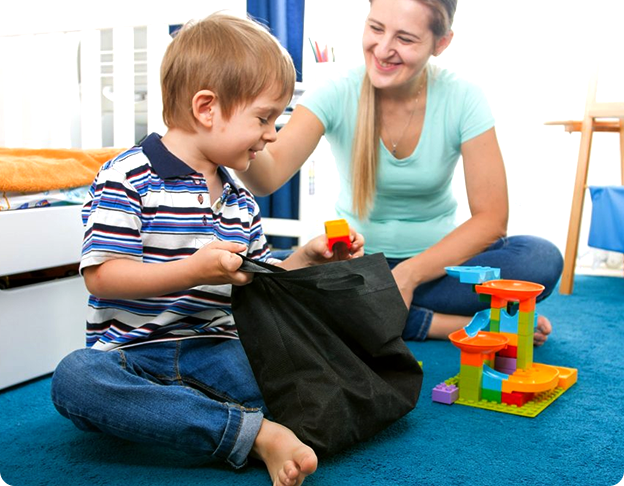As a parent of a child with autism, you’ve likely been in this situation before:
You recognize your child exhibiting challenging behaviors in everyday situations. It could be repetitive actions, attention-grabbing, or general challenging behaviors to get out of doing tasks you present to them. Whatever the case may be, your child seems to always resort to those behaviors.
While these unwanted behaviors can be tricky to overcome, there are ways to reduce or prevent them from occurring. The key is to utilize proactive strategies that address problematic behaviors before they happen.
What are Proactive Strategies?
Proactive strategies are ABA therapy techniques used to shape and change the social environment, or how your child interacts with the environment. The strategies aim to reduce the frequency of a challenging behavior or prevent it from occurring at all.
It’s all in the name. When you implement proactive strategies, you’re taking action to alter the situation instead of responding to actions after they happen.
How Can Proactive Strategies Address Behavioral Problems?
All children are different. The key is to individualize your approach to the child’s needs and challenges. That said, adopting proactive strategies can provide a slew of benefits across the board.
To start, it helps to reduce the chance of a behavior challenge from occurring. Successful implementation may eventually mold your child’s outcomes, essentially preventing challenging behaviors and increasing appropriate behaviors.
Beyond that, however, is the chance to increase the behaviors you want to see. Preventing outbursts and providing your child with learning opportunities to teach alternative and appropriate behaviors is key. It builds a sense of pride in their accomplishments, helps them build personal responsibility, and can even reduce the frustration of learning.
Key Considerations for Proactive Strategies
Before you begin using proactive strategies, there are several things to take into account.
Your Goals
One of the most critical aspects of therapy is setting realistic goals. Manage your expectations and keep your goals within reach for your child. Asking too much too soon may lead to setbacks and new challenges. You want your child to feel motivated and rewarded, so don’t be afraid to modify activities to meet your child in the middle.
Why the Behavior Occurs
Next, you’ll want to think about why your child partakes in the challenging behavior. There are four functions of behavior that drive action. Understanding the purpose behavior serves can help you develop strategies that target the problem at the source
What Elicits a Response?
A proactive strategy will only work if your child responds to it. Not all kids learn the same way. Some connect strongly with visual reminders like cards or written schedules. Others might prefer auditory cues like timers. It is ideal to find out what works for your child to ensure the strategies have the most impact.
Positive Behaviors Worth Reinforcing
Being proactive isn’t all about preparing for the worst. It’s also about catching them being good while refraining from providing attention to the behaviors you do not want to see. Figure out what the appropriate behaviors are and reinforce them. For example, you can provide praise when they finish chores or complete lessons. This helps your child learn what they did well and what provides them with more praise and reinforcement.
Effective Proactive Strategies to Implement
Here are some of the most widely used techniques you can adapt to your child’s specific needs.
Sterilize the Environment
Also known as “sanitizing the environment,” this technique is about removing distractions. The idea is that eliminating all potential distractions leaves your child with less things to get distracted by and increases focus on the task at hand.
For example, you can make sure that all toys are in a Tupperware container or bag, and unnecessary items are not aimlessly scattered around. For a child who gets up and runs away from a task, a good option would be placing them away from the door or closer to you to prevent elopement.
Priming
In the world of ABA, priming is setting the stage for success. Think of it as a preview or a warning.
When you prime your child, you’re letting them know what to expect. Some good examples include having a visual that showcases their schedule for the day. Another would be modeling the task ahead of time or explaining new situations before they occur. The goal is to help your child become more prepared and know what to expect.
First-Then Language
First-then language is a simple form of communication that serves many purposes. It details your expectations and lets your child know what they need to do. It also highlights what they’ll get in exchange once they complete the task or activity.
Task Interspersal
Task interspersal is a therapy technique that involves intermingling easy and complex tasks.
Before moving onto a less-desired activity, you can start your child off easy. For example, if you are teaching your child how old they are but they already know how to give high-fives and sing along to songs, you could sing their favorite songs, ask them to give you a high-five, and teach them how old they are. This can help the child remain motivated, even if the skill they are learning is difficult
Offer Choices
Providing choices enables your child to do the activities they preferred. Let’s say that you’re trying to get your child to clean their room. You can pose them with a question and say, “Do you want to clean up by yourself or do you want me to help you?” You can also provide choices on what they would prefer to clean up first
Noncontingent Reinforcement
Noncontingent rewards don’t depend on your child’s actions. Usually, reinforcing positive behaviors is about making those rewards contingent on certain behaviors or actions. However, a noncontingent reinforcement is like giving a freebie before the challenging behavior has an opportunity to occur.
The best way to do this is to use reinforcers that counteract the function of the behavior. For example, you could build breaks to prevent the child from becoming tired or give praise to provide attention.
Visual Support
While you implement these strategies, consider utilizing visual aids. Visual supports help to improve understanding, provide some structure, and encourage independence.
You can use:
-
-
- Posters
- Token cards
- Short videos
- Timers
- Symbols
- First-Then boards
- Schedules
- Reference sheets
-
Try Proactive Strategies in Your Home
Adopting proactive strategies can do a lot to prevent challenging behaviors. The more you prevent these behaviors from occurring, the less your child relies on them. This can also provide opportunities to teach more appropriate alternative behaviors. Implementing impactful techniques can teach them healthier alternatives for long-term success.
Ready to try implementing proactive strategies with your child? Download our Beginner’s Kit to keep record of the strategies you use, along with the progress your child has made!





